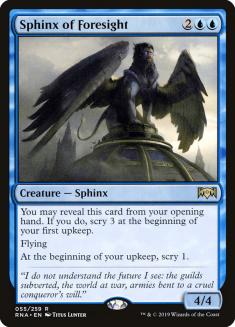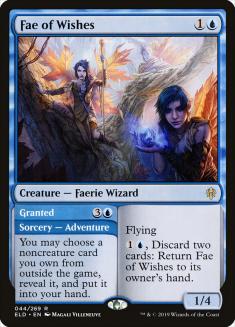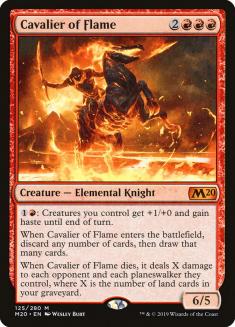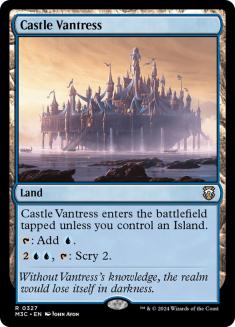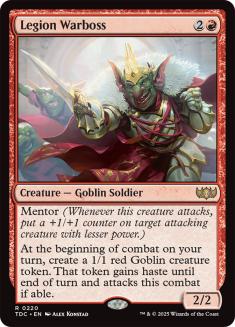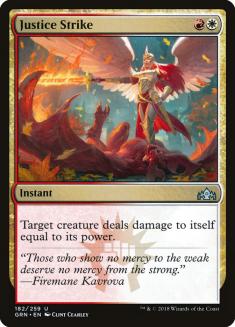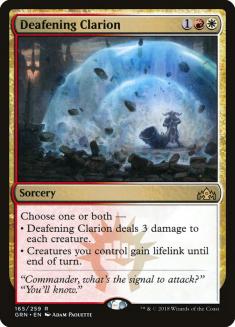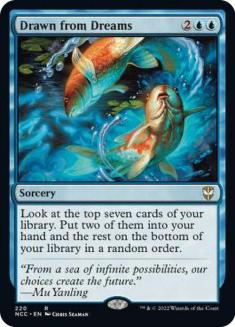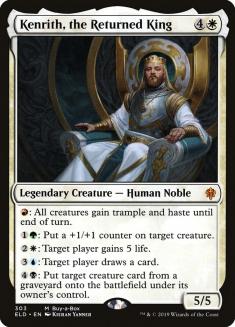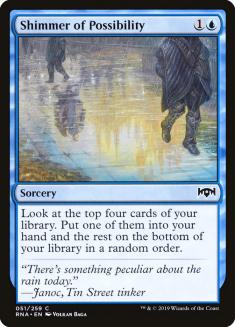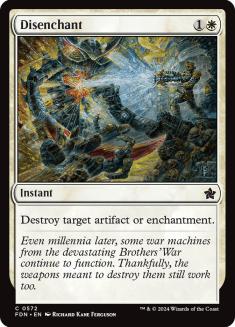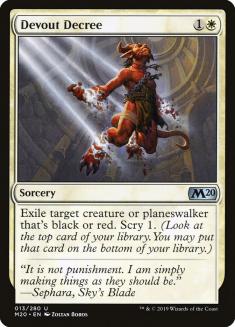By the time you read this article, Mythic Championship VII will have already started. This is the deck I chose to play:
Creatures (15)
- 4 Sphinx of Foresight
- 4 Cavalier of Flame
- 3 Cavalier of Gales
- 2 Kenrith, the Returned King
- 2 Bonecrusher Giant
Planeswalkers (4)
Lands (27)
Spells (14)

Here are some of the reasons I chose Jeskai Fires:
- The deck is just consistently very powerful. Fires of Invention is one of the strongest things you can do in Throne of Eldraine Standard, and between Temples, Sphinx of Foresight, and Shimmer of Possibilities, this deck is the best at finding and casting Fires of Invention. I didn’t feel like I could accurately predict the metagame at the Mythic Championship (it’s not like the previous two where we knew it was going to be mostly Golos decks and then mostly Food decks), so I opted to play a proactive strategy that didn’t rely on getting the metagame right.
- This deck gets the biggest boost from open decklists of all the decks in the format and I think it’s by a wide margin. Most of the time, having open decklists will impact whether you keep or mulligan your hand and what card you send back if you do mulligan. Jeskai Fires ups the stakes with Sphinx of Foresight (as well as more Temples than any other deck), which can force you to scry before you even know what your opponent is playing. It also has cards that are excellent in some matchups and dead in others, like Deafening Clarion or Aether Gust. Resolving a Turn 1 Sphinx of Foresight and seeing both Teferi, Time Raveler and Deafening Clarion against an unknown opponent is an unsolvable problem that could flat-out lose you the game (imagine drawing a Clarion instead of a Teferi in the mirror, or the other way around versus Rakdos), and open decklists make that a non-factor and really maximize the power of your early-game scrying.
- Sphinx of Foresight really did give the deck a huge leg up from previous versions. It’s the best card for finding Fires of Invention, a great card to cast and impact the battlefield in the same turn you cast Fires (which was previously lacking), and an integral part of your fair plan, which is now actually competitive. Between sweepers, Bonecrusher Giant, Sphinx of Foresight, and the Cavaliers, you have a decent backup plan of just casting big creatures and killing the opponent. Some players assume that if they deal with Fires they’ve got the matchup covered and fill their decks with cards like Duress and Thrashing Brontodon, but the addition of Sphinx of Foresight to the deck has made it so that you can just curve out reasonable bodies and win from there.
- It’s actually pleasant to play, as you don’t have to click Food/Cat/Oven 150 times in a game, sucking all the fun from the world for both you and your opponent. This isn’t the most defining of factors but it’s a nice bonus.
The first thing you might notice from my list is that, despite saying I was partial to Fae of Wishes in my latest article, I am not playing it. It’s a very powerful card that fits the deck really well, but after testing it more this past week I found the metagame to be too hostile to it. The main issue is that, in metagames past, almost no one interacted with your Fires of Invention; if you had it on the battlefield, you knew it was going to remain on the battlefield (or at worst be bounced). Nowadays cards like Thrashing Brontodon and Casualties of War are very common, and they can permanently get rid of your Fires.
During my matches, what would often happen was that I’d play Fires of Invention and then Granted for something like Casualties of War, that I intended to cast on a future turn. My opponent would then destroy my Fires, rendering the card I wished for uncastable. This happened enough that I started having to save the Fae of Wishes to cast both Granted and the card itself in the same turn, and that was enough for me to not want to play it.
The secondary issue is that, nowadays, the aggro decks aren’t really the Mono-Red type anymore; they rely on utility creatures that can’t be blocked and cards like Embercleave. Fae of Wishes is an excellent blocker if you’re trying to stop Scorch Spitter, but it doesn’t do much versus Stormfist Crusader, Midnight Reaper, or Rotting Regisaur, as you need actual removal for these cards. So I’ve opted to play without Fae of Wishes, and instead with Bonecrusher Giants and Justice Strikes, as well as more Shimmer of Possibilities to find my key cards, similar to Zvi Mowshowitz build of the deck.
This deck is remarkably straightforward to play, as you have one direct gameplan and never deviate from it. Ideally, in every game of every match, you want to resolve Fires of Invention. Then you want to follow it up with two five-drop creatures and ideally kill them in two turns. If you can’t do that, then you just cast four- and five-mana creatures until you’ve won, sweeping the battlefield from time to time.
Here are some tips to playing the deck:
- Deafening Clarion is extremely powerful in this deck and the lifelink mode is not to be underestimated, as you attack for huge chunks in your Fires turns. When I first started playing the deck, I would always just cast Clarion on Turn 3 to clear the battlefield, but now I often just hold it for Turn 5, when it gains me way more life than casting it on Turn 3 would have saved. If you’re playing this deck, consider holding Clarion a little more.
- You can keep a wide range of hands with this deck. Almost every functional (e.g. two to five lands) hand with Fires of Invention is a keep, and most hands with Sphinx of Foresight or Shimmer of Possibility are as well. I would also keep a subset of hands that don’t have any of these cards if they have the right lands and some cards that I can cast in the middle of the game.
- Be conscious of your scrys when you’re overlapping Temples and Sphinx of Foresight. Most of the time, you should not hinder your land development in order to get extra scrys. You should still lead with your Temples even if you already know you’re keeping the card (unless of course the game is scripted out in a way where you can just play a Temple later without hurting you; it’s easy to know if you know your top cards). What you should do, however, is consider that there’s a small extra cost to keeping any card on top with Sphinx of Foresight if you’re going to scry into it again. For example, you might look at the top card (say, a Fabled Passage) and think, “I wouldn’t cycle Fabled Passage for a random card, so I will keep it.” If you’re going to play a Temple, what you should instead think is, “Would I trade Fabled Passage for a scry and a card?” because that’s what you’re getting if you bottom it, and it might tip the scales so that you do.
- Be more aggressive with Cavalier of Flame in terms of what you’re discarding. I often see people discard two or three cards and hold onto something mediocre “just in case,” when the right play is to just discard everything and hope you’ll draw something to cast. Obviously if that Bonecrusher Giant is enough to win, then you should just keep it, but in most situations you should not keep a medium card.
- If you have Fires of Invention and Castle Vantress on the battlefield, you should often scry with the Castle on your upkeep, unless you specifically need to cast and activate a Cavalier of Flames or Kenrith, the Returned King and this would stop you from doing that.
- If you have Fires of Invention and both Castle Vantress and Kenrith, the Returned King on the battlefield, it’s often better to scry 2 than to draw a card, since you’re looking for quality over quantity.
- Justice Strike will automatically kill any creature with deathtouch, such as a pumped-up Knight of the Ebon Legion.
- Cavalier of Gales is very bad versus Narset, Parter of Veils. Avoid at all costs. If you unwillingly cast Cavalier of Gales into Narset, you’re forced by the rules of Magic to shame-concede and pretend it was your little sibling playing on your account.
Sideboarding with Jeskai Fires is also straightforward, as your gameplan remains the same against everyone and it’s usually obvious which cards are good and which cards are bad. Against opponents without many creatures, you start cutting removal: first Deafening Clarion, then Justice Strike. Against opponents with many creatures, you usually cut a combination of Teferi, Time Raveler and Shimmer of Possibility. Shimmer just gets cut a lot in general because other people will have ways to answer your Fires after sideboard, so the games become grindier and not only about finding it, and also because you bring in cheap interaction that you can cast in the turns where you’d otherwise be casting Shimmer.
The most common card that people play and I don’t is Legion Warboss. Legion Warboss is an excellent card against certain decks (for example, Azorius Control and Temur Reclamation), but I believe these decks are on the decline, which means I don’t want to include a card for matchups I expect to face 5% of the time (for example, it wouldn’t surprise me if zero people played Azorius Control at the Mythic Championship, but we’ll see).
Legion Warboss is also a card that’s good in the mirror … if you’re on the play. If you’re on the play, you force them to react to it and then you can stick a Fires of Invention, or you just stick it on Turn 3, untap with a threat, and sit on counterspells for a couple of turns until you win.
The problem with Legion Warboss in the mirror is twofold. First, even on the play, it can be answered by cards they might actually want in their deck, such as Aether Gust or Justice Strike, which means you don’t actually put them in the squeeze of having to have otherwise bad answers like Deafening Clarion or Lava Coil. The worst-case scenario is that they keep Bonecrusher Giant, which is not a good card but is also not a disaster as an answer. Sometimes they won’t have an answer and it will run away with the game, but sometimes they will simply kill it and it will do nothing (and sometimes they will cast a Sphinx as a blocker and it will also do nothing).
Second, I don’t think it’s actually a good card on the draw. It gets outclassed by the deck’s primary gameplan (Fires into big creatures), so if you’re on the draw and your Turn 3 is Legion Warboss, they can just answer with Fires plus a big card of their own and you’re in trouble. I think that, on the draw, having answers to Fires is more valuable (Aether Gust or Mystical Dispute), but having these answers means you can’t actually tap out on Turn 3 to cast Legion Warboss.
In the end, I’ve opted not to play Legion Warboss. I understand the appeal of it, and if I expected more decks like Azorius Control or Temur Reclamation I would have played them, but I expected a little more Rakdos and Gruul Aggro so I decided to play more removal instead.
This is how I sideboard against the most popular decks:
VS Jund/Golgari Food
Out:
In:
This is the matchup where I most wish I had access to a better sideboard card, because you have a lot of suboptimal cards in the maindeck that you don’t mind taking out (extra Clarions and Teferis, for example, and some of the cards I’m sideboarding in aren’t even very good). I’ve opted for some more threat density with an extra Kenrith (which is the best of the creatures, since it tramples over the Cats) and a Drawn from Dreams, but I wish we could do better. It’s possible to bring in the third Aether Gust as well (and I do it versus Jund builds) but against straight Golgari I’m not a fan as you don’t have many targets, and the best target (Casualties of War) is one you can’t hit if you have Fires on the battlefield.
Some people ask about bringing in Disenchant versus them, to break up the Oven combos, but I don’t really think it’s an efficient enough use of a slot; the game is more about killing them through the combo rather than stopping them from assembling the combo to begin with. If you give them enough time, they’ll just assemble it again. A card like Sorcerous Spyglass would be good to stop all Oven shenanigans forever, except for the fact that it just incidentally dies to Casualties of War, which makes it unplayable right now.
VS Jeskai Fires
Out:
In:
Between three Justice Strikes and three Aether Gusts, I feel like I have enough Legion Warboss coverage without needing Bonecrusher Giant in my deck, but it’s possible to have one or two on the draw. Mystical Dispute often gets stuck in your hand without doing anything (it’s bad with your own Fires and versus their Teferi) but I think it’s sort of a necessary risk, as when it’s good, it’s very good, and it’s one of the few ways of letting you break serve in the mirror.
VS Rakdos Aggro
Out:
In:
Aether Gust is the one card that changes in value here, depending on what their list looks like. If they only have Stormfist Crusader, Embercleave, and Fervent Champion, I’m not a fan. If they have Rimrock Knights as well, or Bonecrusher Giants, it starts becoming better than Teferi, Time Raveler.
VS Golgari Adventures
Out:
In:
This matchup also depends on which version of the deck they’re playing. If they are heavy green (with Nissa, Who Shakes the World; Vivien, Arkbow Ranger; and Questing Beast), Aether Gust is quite good. If they are the black-heavy version, Aether Gust is bad. I’ve mostly seen the green version lately so this is what I recommend.
VS Gruul Aggro
Out:
In:
Teferi isn’t great versus them, but it does stop them from casting Embercleave, so I like keeping in two. Most people don’t have Shifting Ceratops against you, but if you see it, you can swap a Cavalier of Gales for the Cavalier of Flame.
Moving Forward
Even though this is the list I submitted, I’ve been playing more with it (and the metagame has also evolved), so I wish I had made a couple of changes and I recommend a slightly different version moving forward. I’d do:
- -1 Justice Strike, +1 Bonecrusher Giant. Bonecrusher Giant is a better card than Justice Strike versus most of the field, and having a Turn 2 and a Turn 3 play in the same card in a deck that’s devoid of early plays is very valuable. I assumed Jeskai Fires would be extremely popular, so I wanted to hedge there a little by having a card that killed Cavaliers, but it doesn’t seem to be the case.
- -1 Cavalier of Flame, +1 Cavalier of Gales (or +1 Kenrith, The Returned King). I’ve had my Cavalier of Flame embarrassed by Cauldron Familiar too many times, and I think playing a different five-drop is better. Kenrith is the actual best in a lot of spots, but it’s legendary and drawing two can be disastrous, so I would probably just play a fourth Cavalier of Gales to fly over the Cats. If you play a third Kenrith in the maindeck, then I’d play a fourth Cavalier of Gales in the sideboard.
Overall, this shouldn’t impact your sideboarding at all, as you can just make the necessary swaps when appropriate.

